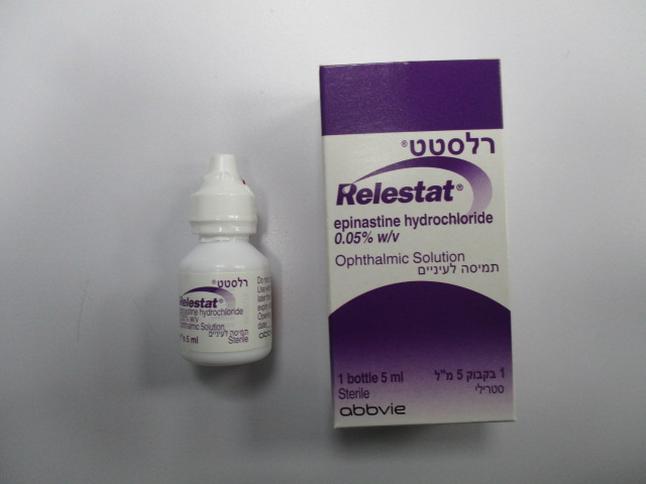Quest for the right Drug

רלסטט RELESTAT (EPINASTINE HYDROCHLORIDE)
תרופה במרשם
תרופה בסל
נרקוטיקה
ציטוטוקסיקה
צורת מתן:
עיני : OCULAR
צורת מינון:
תמיסה לעין : EYE DROPS, SOLUTION
עלון לרופא
מינוניםPosology התוויות
Indications תופעות לוואי
Adverse reactions התוויות נגד
Contraindications אינטראקציות
Interactions מינון יתר
Overdose הריון/הנקה
Pregnancy & Lactation אוכלוסיות מיוחדות
Special populations תכונות פרמקולוגיות
Pharmacological properties מידע רוקחי
Pharmaceutical particulars אזהרת שימוש
Special Warning עלון לרופא
Physicians Leaflet
Adverse reactions : תופעות לוואי
4.8 Undesirable effects Summary of the Safety profile In clinical studies, the overall incidence of adverse drug reactions following Relestat was less than 10%. No serious adverse reactions occurred. Most were ocular and mild. The most common adverse reaction was burning sensation in eye (mostly mild); all other adverse reactions were uncommon. Tabulated list of adverse reactions Within each frequency grouping, adverse reactions are presented according to System Organ Class in order of decreased seriousness. The following terminologies have been used in order to classify the occurrence of undesirable effects: Very common (≥1/10); common (≥1/100 to <1/10); uncommon (≥1/1,000 to <1/100); rare (≥1/10,000 to <1/1,000); very rare (<1/10,000); not known (cannot be estimated from the available data). The following adverse drug reactions were reported during clinical trials with Relestat: System Organ Class Frequency Adverse Reaction Nervous system Uncommon Headache disorders Eye disorders Common Burning sensation, eye irritation Uncommon Conjunctival/ocular hyperaemia, eye discharge, eye dryness, eye pruritus, visual disturbance Respiratory, thoracic and Uncommon Asthma, nasal irritation, rhinitis mediastinal disorders Gastrointestinal disorders Uncommon Dysgeusia The following adverse drug reactions were reported during post marketing use of epinastine in clinical practice: System Organ Frequency Adverse Reaction Class Immune system Not known Hypersensitivity reaction including symptoms or disorders signs of eye allergy and extra-ocular allergic reactions, including angioedema, skin rash and redness Eye disorders Not known Increased lacrimation, eye pain, eye swelling, eyelid oedema Paediatric population Frequency, type and severity of adverse reaction in adolescents ≥ 12 years of age are expected to be the same as in adults. There is limited experience in children aged 3-12 years regarding frequency, type and severity of adverse reactions. Adverse reactions reported in phosphate containing eye drops Cases of corneal calcification have been reported very rarely in association with the use of phosphate containing eye drops in some patients with significantly damaged corneas (see section 4.4). Reporting of suspected adverse reactions Reporting suspected adverse reactions after authorisation of the medicinal product is important. It allows continued monitoring of the benefit/risk balance of the medicinal product. Any suspected adverse events should be reported to the Ministry of Health according to the National Regulation by using an online form: https://sideeffects.health.gov.il

שימוש לפי פנקס קופ''ח כללית 1994
לא צוין
תאריך הכללה מקורי בסל
לא צוין
הגבלות
לא צוין
מידע נוסף
